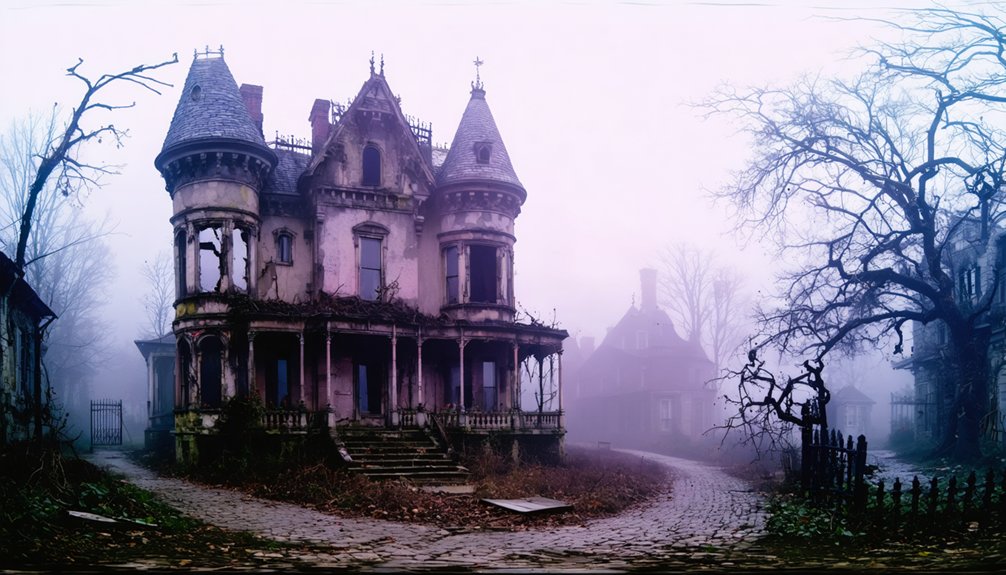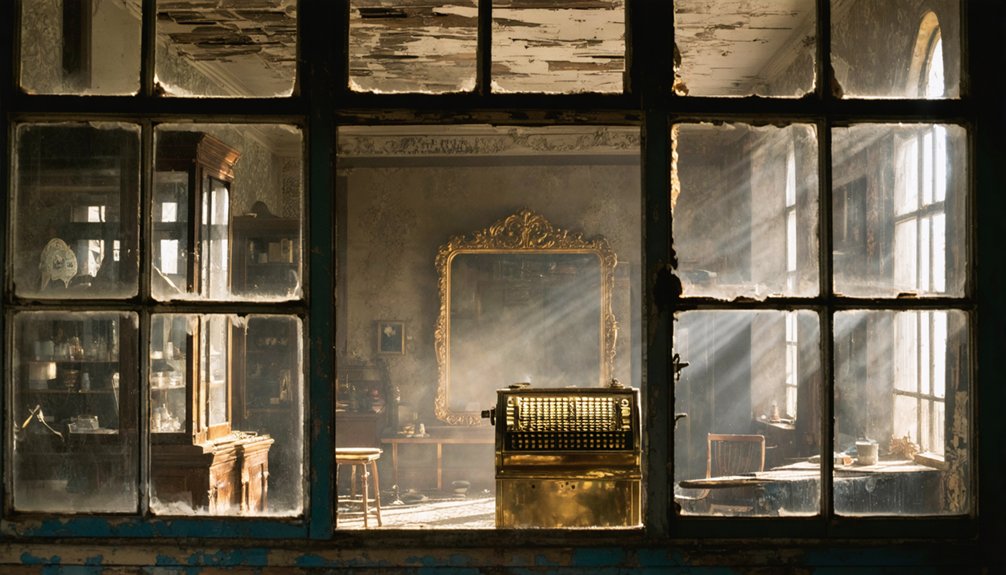You’ll find America’s most hauntingly preserved Victorian-era ghost towns in Bodie, California, where 170 structures stand in “arrested decay,” and Virginia City, Montana, with over 300 historic buildings. Don’t miss Kennecott, Alaska’s abandoned copper empire, South Pass City, Wyoming’s frontier gateway, and Centralia, Pennsylvania, where an underground fire still burns beneath empty streets. Each settlement offers a window into the opulent yet fleeting prosperity of America’s industrial golden age.
Key Takeaways
- Virginia City, Montana preserves over 300 buildings with more than half predating 1900, meticulously maintained since the 1940s.
- Bodie, California stands as America’s most intact ghost town with 170 weathered structures preserved in “arrested decay” since the Gold Rush.
- South Pass City, Wyoming features over 20 original structures from 1867-1868, including Wyoming’s oldest standing jail.
- Kennecott, Alaska showcases abandoned copper mining infrastructure from the early 1900s within Wrangell-St. Elias National Park.
- Centralia, Pennsylvania offers a unique abandoned townscape consumed by an underground fire since 1962, with few remaining structures.
Bodie, California: Frozen in Time Since the Gold Rush
The rugged silhouette of Bodie stands as America’s most intact ghost town, suspended in perpetual twilight since the final days of the Gold Rush era. Founded after William Bodey’s 1859 gold discovery, this boomtown swelled to 10,000 souls by its peak, yielding over $35 million in precious metals—billions in today’s currency.
Bodie’s preservation in “arrested decay” began with its 1962 designation as a California State Historic Park. You’ll walk dusty streets among 170 weathered structures still furnished with Victorian-era possessions, as if residents vanished mid-life. Visitors should note that the name “Bodie” requires careful disambiguation as it refers to multiple locations and surnames throughout the United States. The hillside cemetery reveals tragic stories of miners who often died in their thirties or younger, victims of the harsh conditions that defined frontier life.
Ghost town legends persist, nurtured by howling winds and mysterious deaths of lingering residents. Mining equipment rusts beside thousand-foot shafts while schoolhouses retain chalkboards with century-old cursive—all evidence of freedom’s fleeting nature in America’s boom-and-bust frontier.
Virginia City, Montana: The Victorian Mining Town That Refuses to Fade
Unlike Bodie’s suspended animation, Virginia City stands as a Victorian gem that breathes with living history—a remarkable contradiction in America’s ghost town landscape.
Sparked by the 1863 gold discovery in Alder Gulch, this settlement rapidly evolved from mining chaos to Montana’s territorial capital.
You’ll find over 300 buildings—more than half predating 1900—meticulously preserved through Charlie and Sue Bovey’s visionary efforts beginning in the 1940s. Their historical preservation work secured the town’s National Historic Landmark status in 1961.
As you wander among the false-fronted commercial structures and Victorian residences, you’re experiencing one of America’s most intact gold rush towns. At its peak, the area produced an estimated $50-$150 million in gold, making it one of America’s richest mining regions.
Though the population plummeted after the mining heyday ended, Virginia City’s architectural heritage thrives as a “very much alive ghost town,” offering an authentic portal to frontier prosperity. The town maintains a small but resilient permanent population of approximately 200 residents as of 2020.
Kennecott, Alaska: Copper Empire in the Wilderness
Deep within Alaska’s formidable wilderness stands Kennecott, a copper mining colossus whose ruby-red mill building still punctuates the landscape like a Victorian industrial cathedral.
Discovered in 1900 when prospectors stumbled upon ore containing up to 70% pure chalcocite, this remote outpost quickly transformed into America’s richest copper producer. The Alaska Syndicate invested $25 million (over $850 million today) to establish this industrial marvel, connected to civilization by a 196-mile railway through treacherous terrain.
The raw economics of frontier alchemy: chalcocite into fortune, wilderness into industry—all via 196 miles of impossible railway.
You’ll find a remarkably preserved ghost town that once hummed with 600 workers earning premium wages while extracting 1.3 billion pounds of copper before the 1938 abandonment. Despite extreme isolation, the town maintained a surprising level of comfort with its own self-sufficient community facilities.
Now protected within Wrangell-St. Elias National Park, Kennecott’s structures remain frozen in time—testament to human ingenuity and the transient nature of industrial prosperity in America’s last frontier. Today, the site is recognized as a National Historic Landmark, having received this prestigious designation in 1986.
South Pass City, Wyoming: Gateway to the Western Frontier
While Kennecott stands as Alaska’s industrial tribute to copper extraction, Wyoming harbors its own Victorian-era relic born of different mineral dreams.
South Pass City emerged in 1867 following a significant gold discovery by Mormon prospectors in the Wind River Mountains, transforming a simple emigrant trail crossing into a bustling frontier settlement.
At its zenith in 1868, this mining heritage site boasted over 250 buildings and approximately 1,000 residents. The Carissa Mine alone yielded $15,000 in gold through rudimentary hand processing. The town reflects the indomitable frontier spirit of settlers who ventured westward during America’s expansion era.
You’ll find this remarkably preserved ghost town listed on the National Register of Historic Places since 1970, with over 20 original structures meticulously restored to their 19th-century condition. Among these historical treasures is the Sweetwater County Jail, built in 1870 and recognized as the oldest standing jail in Wyoming.
When you visit this Wyoming State Historic Site today, you’re walking through one of America’s most authentic abandoned settlements—a genuine portal to frontier freedom.
Centralia, Pennsylvania: The Ghost Town Still Burning Below
When most abandoned Victorian towns slowly decay due to economic decline or population shifts, Centralia, Pennsylvania presents a dramatically different narrative—a community literally consumed from below.
This once-thriving coal mining settlement met its demise in 1962 when an underground fire ignited in abandoned mine tunnels, creating an apocalyptic landscape that persists today.
You’ll find toxic gases seeping through street cracks and sinkholes that have swallowed homes and infrastructure. The town’s population dwindled from 3,000 to fewer than ten resilient souls who secured lifetime residency rights through litigation. Scientists predict the underground fire may continue to burn for another 250 years, making Centralia’s environmental disaster far from over.
Centralia today: a ghost town where earth belches poison and only the most stubborn remain against all odds.
Though authorities demolished most structures, you can still observe St. Mary’s church amid the desolate streets. Visitors often encounter the infamous Graffiti Highway, a vibrant stretch of abandoned Route 61 decorated with colorful artwork where the asphalt buckled from underground heat.
Despite environmental warnings, the site draws urban explorers fascinated by its haunting atmosphere—a Victorian community transformed into the real-world inspiration for Silent Hill.
Frequently Asked Questions
How Safe Are These Abandoned Towns for Visitors With Children?
While some imagine unrestricted exploration, you’ll find most abandoned towns require visitor precautions. They’re unsafe for unsupervised children, but established sites offer child-friendly activities when proper permissions and safety protocols are followed.
What Paranormal Activity Has Been Reported at These Historic Sites?
You’ll encounter numerous ghost sightings at these haunted locations—apparitions of miners, phantom footsteps, disembodied voices, and cold spots. Paranormal researchers have documented EVPs and electromagnetic anomalies throughout these Victorian-era remnants.
Can Tourists Legally Collect Artifacts or Souvenirs From These Towns?
Imagine dust-coated treasures beckoning your touch. You can’t legally remove artifacts from these historic sites. Artifact preservation laws prohibit collection without permits. Souvenir legality hinges on strictly regulated exceptions that rarely apply to tourists.
Which Abandoned Town Offers the Best Photography Opportunities Year-Round?
Bodie, California offers you’ll find unparalleled year-round photography tips with authentic scenic viewpoints. Its 110 preserved Victorian structures capture golden-hour light magnificently, affording the unfettered documentarian freedom to explore America’s genuine architectural past.
Are Any of These Towns Accessible for Visitors With Mobility Issues?
Forget perfectly preserved Victorian romance—you’ll encounter dusty realities. Bodie offers limited wheelchair accessibility through paved pathways, while St. Elmo and South Pass City provide visitor accommodations on relatively level terrain for mobility-challenged explorers seeking historical liberation.
References
- https://www.wideopencountry.com/the-10-eeriest-ghost-towns-in-america/
- https://dot.ca.gov/-/media/dot-media/programs/environmental-analysis/documents/ser/townsites-a11y.pdf
- https://www.youtube.com/watch?v=nvjuXjhvagk
- https://www.thediscoverer.com/blog/7-abandoned-towns-around-the-world-you-can-actually-visit/YJW7NWfpMgAGbRg5
- https://www.aol.com/12-ghost-towns-were-once-143618310.html
- https://www.geotab.com/ghost-towns/
- https://www.youtube.com/watch?v=e_TV-DqHGlk
- https://en.wikipedia.org/wiki/Ghost_town
- https://en.wikipedia.org/wiki/Bodie
- https://decorhint.com/the-deserted-california-town-where-history-still-lives/



